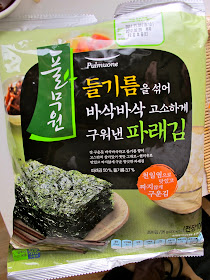When I was a kid, I was the pickiest eater. I wouldn't eat chocolate (as a 7 year old, WTF), mayonnaise, cream cheese (strawberry or plain), avocados, cucumbers, onions (still kind of true), pork (not ham, chops, or even bacon - no, I'm not Jewish), bell peppers, beans...I could go on and on. As I grew older, my fear of strange foods melted away with each palate-opening episode.
California Rolls aren't my favorite roll. Per contra, I appreciate it for how it changed my life towards avocados (black-listed) and cucumbers (black-listed). My mom's friends own a sushi restaurant back in Texas. I worked there as a sixteen year-old for two weeks to earn money for my trip to Europe. Not wanting to embarrass my family (so Korean of me), I dutifully ate whatever was put in front of me. It's a sushi restaurant. Obviously, I was obligated to eat that avocado and cucumber stuffed contrivance. I honestly felt like they had plunked down a platter of boar testicles for me to eat. I ate it (the cali roll, not the testicles). I loved it. Avocados and cucumbers pardoned from the blacklist.
It's pretty obvious to make sushi, you'll need sushi rice. No substitutions - no basmati, no long grain, no medium grain.
Delicious sushi rice is a result of layering delicate flavors. To start, you'll need to rinse the rice to rid it of excess starch. Wash the rice 2-3 times until the water is nearly clear. Then soak the rice for 30 minutes.
The rice needs to be cooked with a 2:1 ratio of water to rice. Since there's already water in the rice pot, I use my hand to measure water. I stick my hand into the pot and press is down flat on the rice. If the water comes up just past my fingers, that's the right amount. I don't know the science behind this, it's just the way my mom does it. For a more exact method, look at the hash lines on the inside wall of the rice cooker. If the rice is up to the first notch, water should be poured to the second notch.
This step is optional. If you have dashima, dried seaweed squares, throw some in with the rice to cook. Discard once done cooking. A bag of dachima sells for 1,400 won (about a dollar) at any local supermarket.
While the rice is cooking, prepare the sugar and vinegar solution. Mix up 1/4 cup rice vinegar, 3 tablespoons sugar, 2 teaspoons salt and some dashima/kombu squares. Heat the solution over medium heat but don't let it boil. Heat until the sugar and salt dissolve. Discard the dashima. Then set aside until ready to use.
Selecting the Right Seaweed Laver
To make maki, you need un-roasted, "raw" seaweed laver. Unfortunately for me, my local supermarket only sells "raw" seaweed laver by the hundreds. So, I had to buy roasted seaweed laver. If I were Japanese, this would be unacceptable. Thank god I don't care; I'm just hungry. If you can, get a hold of un-roasted seaweed laver (whole sheets).
 |
| This is sacrilegious roasted, oiled and salted seaweed laver. Unfortunately, if the seaweed is going to be roasted in Korea, it will most likely also be oiled and salted. |
sushi rice (4 cups cooked)
seaweed laver
1 avocado (cut into strips)
1 cucumber (cut into strips)
1 package imitation crab meat (shredded into strips like string cheese)
flying fish roe (optional)
Rolling Out
To start rolling the sushi, you'll need a bamboo maki rolling mat. It's 1,000 won ($1) anywhere. Wrap the bamboo mat in plastic wrap. Because the California Roll is an inside-out roll, the plastic wrap keeps the rice from sticking to the mat.
Cut the seaweed laver in half using a pair of kitchen scissors. Place the laver onto the bamboo mat about two inches from the edge facing you.
Keep a bowl of water on the table to wet your hands and knife. Wet your hands and take a big clump of rice and spread it evenly onto the laver. Use even pressure and don't press too hard and smash the grains.
Then flip the rice-covered laver over so that the rice is downward-facing onto the bamboo mat. Then put a slice of cucumber across the seaweed. If it hangs over the edge, that's okay. The ends will be trimmed. Then lay down slices of avocado. Then the imitation crab meat.
To roll the maki, roll the end of the seaweed up and over the avocado, cucumber and crab and tuck in towards you. Keep nudging forward by going up and over then squeezing towards yourself. By the time you reach the edge of the bamboo mat, you'll have a roll.
Roll the roll in flying fish roe.
Slicing Maki
Slicing maki is tough if you're using a $3 knife from Daiso. If you're wondering why my maki looks like I hacked them apart using a turkey knife, it's because Santa has yet to bring me my Takeshi Saji knife set.
Anyway, you can make cutting a bit easier with some water. Wipe the blade after each cut so the blade can slice easily through the rice and seaweed. Also, use a seesaw-type, up-and-down sawing motion to get the blade to make it's way through the layers. If you just press down like you're slicing a watermelon, you'll smash the roll and the insides will just poop out the ends.
Serve up with some pickled ginger, wasabi, and soy sauce. Yom yom yom.












No comments:
Post a Comment